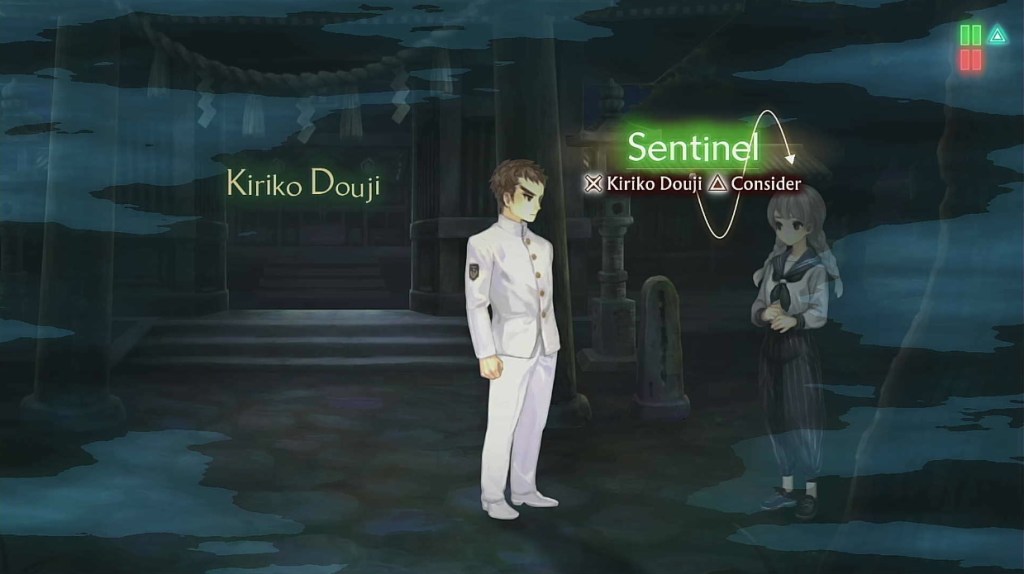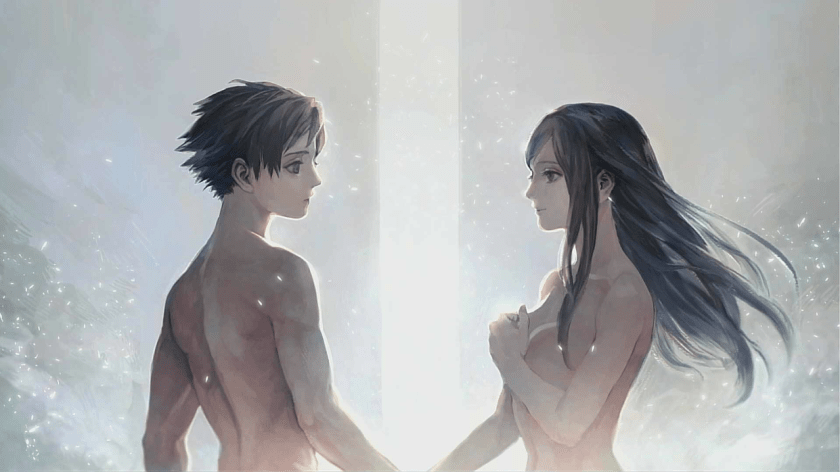Vanillaware’s 13 Sentinels: Aegis Rim starts with massive machines destroying Japan while the young Iori Fuyusaka emerges from the fleeing mob and climbs aboard a giant robotic Sentinel to fight back as her classmate Juro Kurabe watches on. It’s a classic scene for the big robot and kaiju genres, until it loads a top down view of the city and gives you control of Iori’s mech until Juro arrives in his own. What follows is a mind-blowing game fusing multiple genres across hundreds of years, starting in the middle of its narrative and telling thirteen different mysteries that reveal how each character was led to this life-defining moment. 13 Sentinels blends two completely unrelated game styles to create an experience impossible for either by itself, ultimately showing how experiences shape myths that prepare people to keep society from repeating mistakes and lead it in new directions.
Structure is a game, story, or visual art’s overall layout, how all elements are organized so it can best relay its message. Every genre has its own proper structure so blending them is difficult as there has to be a single anchor point that allows different types to exist on one foundation. In 13 Sentinels, that anchor is its multiple characters, as each can relay a core narrative thread separately while placing them all on the same battlefield where their collective strength will overcome their mutual threats. It allows a story-focused visual novel and a systems-heavy strategy RPG to merge smoothly into a single game design.
Aegis Rim’s structure is a fascinating departure for Vanillaware, famous for their gorgeous 2D side-scrolling beat ‘em ups based on classic mythologies, but it’s inspired in practice. Vanillaware’s head honcho George Kamitani is an expert in structure and as he proved with Odin Sphere and Muramasa: The Demon Blade can weave stories referencing religious and historical elements. In 13 Sentinels, he utilized the pop culture myths that had taken over the world in the 20th century, blending classic fiction as diverse as War of the Worlds, Godzilla, The Terminator, and Steins;Gate into one narrative, fitting each appropriately into the handful of times its story takes place. The result shows a snapshot of the modern era and how the present led from the past to determine the future.
With their emphasis on character interaction to build a plot rather than complex controller mechanics or systems, the visual novel structure’s prime concern is telling a story. Because they task the player with questioning characters or presenting evidence, VN narratives move quickly. By comparison, action games that put players through an obstacle course of enemies is limited to telling a story at certain points, usually the beginning and end, and so there are fewer, more spread out, story beats. To help the investigation, 13 Sentinels streamlines its inventory into Thought Clouds with all the info each character has collected that they can use to think on a specific item or present to others. Since the game is about collecting one piece of info to get another, the game consists of sequences of events that move each character from point A to B to C in a line that ultimately leads to a dramatic reveal.
It’s amazing that Vanillaware hadn’t produced a visual novel prior to Aegis Rim considering how well their art is suited to the genre. Like the side-scrollers the company had become known for, every pixel on screen characterizes the game, infusing each character with humanity and densely packing every setting with detail. The dozens of different locations are filled with information, from tens of thousands of drawn items and scripted NPCs comprising hundreds of animations, all in service of telling a tight story in a fully realized world ranging from WWII Japan to a high-tech future society. Every place tells a story and every character is a product of their particular time.
As a story is a series of events that lead from one point to the next based on its character’s goals, a narrative comprised of thirteen distinct arcs will naturally have more events than one with only a few, and thus dramatic, story altering events will occur in quick succession. Each of 13 Sentinels’ stories are divided into sequences of a few scenes that can jump around in the overarching timeline.
Just as people tend to spend their time in the same place, each story returns its protagonist to the same setting at the start of each sequence and branches out in new directions depending on the info they collected in their last run. An excellent example is the curious case of Nenji Ogata, the 1980’s street tough living a Groundhog Day-esque time loop where the only escape from a train platform is to investigate why he’s trapped repeating the same few minutes. Each character is well-defined and each individual sequence is a unique scenario that fits with their overall journey while intricately networking all their connections, relationships, and revelations.
It’s no small feat to tell a story like this on its own, but what’s truly impressive is how it unravels in layers while providing the freedom to pursue it in your own way. It’s no exaggeration to say the story can be experienced in hundreds of different ways and still reach the same end- experiencing each character’s trials as they discover who they are and ultimately why they climb into their Sentinel to save the future.
It is here that the story-focused visual novel design combines with its strategy gameplay: directing this team of pilots against the hordes of gargantuan enemy robots trying to destroy their homes.
Outside of telling its complex story, Vanillaware’s beat ‘em up style isn’t appropriate for a game like 13 Sentinels considering its large roster of characters, so Kamitani and team departed from their other titles to put six of the thirteen main character’s sentinels on the battlefield at once. This is important for a number of reasons- not only does it allow you to feel the desperation firsthand but reinforces the idea that everyone needs to cooperate to survive. It is simply impossible to convey this same sense of teamwork and scale entirely from a side-scrolling perspective.
Giant robot and kaiju science fiction were the results of Japan’s experiences in World War II. By then, tanks had become a staple of the battlefield, and human-piloted mecha became popular in manga like Mazinger-Z and only entrenched itself further into the culture thanks to anime like Mobile Suit Gundam, Macross, and Neon Genesis: Evangelion. At the same time, Godzilla established kaiju flicks as a metaphor for the horrors of atomic warfare after Hiroshima and Nagasaki saw it up close. War became inseparable from both genres and the existence of society-ending threats was burned into Japan’s collective psyche where young people needed to develop strength, grow to greater sizes, to fight back.
13 Sentinels’ strategy design is streamlined compared to many others of the genre, combining real-time with turn-based scenarios predicated on defending a single terminal from invaders. The cast of heroes offer three types of sentinels with a wide-range of abilities and moves, some close-quarters melee and some with long-range missile barrages, others forced to walk the streets between buildings while the rest fly straight to the target. Each requires different strategies to use effectively and rely on smart positioning to maximize damage or lay sentry bots to protect an area. There’s a surprising amount of depth in these fast-paced fights.
Mecha is the perfect analogy for the game’s most important themes, the ideas of transplanting one thing into another to make something new. Vanillaware had explored ideas of transplantation and synthesis in its other Japan-centric Muramasa: The Demon Blade, which told the stories of the maiden Momohime possessed by a vengeful spirit and the roving ronin Kisuke wandering Honshu’s countryside, but Aegis Rim explores the ideas in dozens of different ways across its game. Where Muramasa utilized Japanese and Buddhist folklore to style its real history, Aegis Rim uses modern myths from fiction spanning the 20th century to warn of real technological and social threats tearing over the horizon.
Transplantation takes on dozens of forms here- of transplanting memories and thoughts into the mind via culture and stories, of consciousness into new bodies and across genders, and even emulating a person’s thoughts as an A.I. into metal skeletons. It’s about relocating somewhere else across geography, time, and space. Mecha has long applied the concept to the act of maturing, placing children into larger bodies, increasing their size and ability, as a metaphor for growing into adulthood. Individuals, ideas, and society all grow, stagnate, and die in a loop of birth, death, and reincarnation. But if a fully matured form is able to fuse with something else and create new life, its offspring will carry a version of it into a new generation.
Every videogame too is about transplanting the player into new bodies, worlds, and stories; they are simulations that combine familiar scenarios into new experiences. They give us perspectives on the world free of our own time and space, giving us the tools to successfully move forward no matter the threat. As its characters learn in their own stories, 13 Sentinels: Aegis Rim’s lesson is that society and people will forever shape and reshape each other, remaining hopeful in the idea that humanity can build a bright new future even while staring down oblivion.
DEVELOPER: Vanillaware
PLATFORM: Playstation 4
2020
Dane Thomsen is the author of ZIGZAG, a sport-punk adventure in a world of electrifying mystery. With the voice of her people as her guide, Alex walks neon purple streets thrown into chaos, wielding the concussive force of her baseball bat the mighty ‘.357’ against the forces of evil. Print and kindle editions are available on Amazon. For sample chapters and to see his other works please check out his blog.





